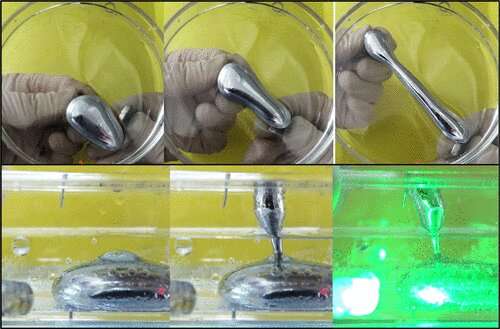Credit: American Chemical Society
In the blockbuster Terminator movie franchise, an evil robot morphs into different human forms and objects and oozes through narrow openings, thanks to its "liquid-metal" composition. Although current robots don't have these capabilities, the technology is getting closer with the development of new liquid metals that can be manipulated in 3-D space with magnets. Reported in ACS Applied Materials & Interfaces, the materials could someday find applications in soft robotics.
Metals that are liquids at room temperature, such as gallium and certain alloys, have unique properties including high conductivity, low melting point and high deformability. These properties make them attractive for use in soft robots and flexible electronics. By adding magnetic particles, such as nickel or iron, researchers can produce liquid metals that they can manipulate with magnets. However, because of their high surface tension, most magnetic liquid metals can only move horizontally, and they must be immersed completely in liquid to avoid forming a paste. Liang Hu, Jing Liu and colleagues wanted to make a magnetic liquid metal that they could move and stretch both horizontally and vertically, without needing to put the material completely in a liquid.
To do so, the researchers first worked with the material submersed in liquid. They added iron particles to a droplet of a gallium, indium and tin alloy immersed in hydrochloric acid. A gallium oxide layer formed on the droplet surface, which lowered the surface tension of the liquid metal. When the team applied two magnets in opposite directions, they could stretch the droplet to almost four times its resting length. They could also manipulate the liquid metal to connect two immersed, horizontal electrodes and, by virtue of its conductive properties, light up an LED bulb. The liquid metal could even stretch vertically and then move horizontally to connect two electrodes—the upper one exposed to air, and the lower one in the hydrochloric acid. This demonstrated that the material didn't have to be fully immersed in liquid. In this way, the magnetic liquid metal was reminiscent of an upright walking amphibian, the researchers say.
More information: Liang Hu et al. Magnetic Liquid Metals Manipulated in the Three-Dimensional Free Space, ACS Applied Materials & Interfaces (2019). DOI: 10.1021/acsami.8b22699
Journal information: ACS Applied Materials and Interfaces
Provided by American Chemical Society
























